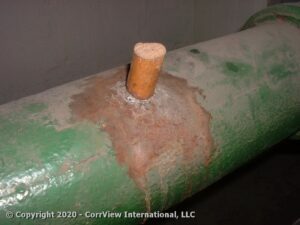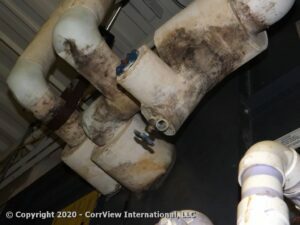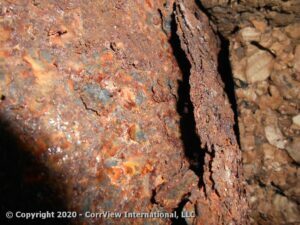Case History: CH-08
Filtration 101
The Most Common Mistakes of Water Filtration Representatives and HVAC Design Engineers |
-
Preface
A past client hires CorrView International, LLC to perform ultrasonic pipe testing at one of their older properties. The pipe was installed in the early 1950’s using extra heavy steel. They do not perform any form of corrosion monitoring and have used many different chemical water treatment companies throughout their history. The quality of their past chemical treatment is questionable.
A common operational problem for the building is large pieces of rust which break off to produce flow restriction for the pump strainers. Rust has sufficiently accumulated in the chiller heads to impact their operation, and have forced mid season condenser water tube cleaning. Some examples of rust they have saved exceed 1 in. in diameter. Frequent manual removal of the pump and chiller strainer elements are required for cleaning. Their condenser water is also tinted a light brown color and has some turbidity.
-
Investigation
Ultrasonic testing shows moderate corrosion activity of near 2-3 MPY, with moderate pitting activity but no serious wall loss. Ultrasonic testing identifies that the pipe has uniformly deteriorated down from an original 0.500 in. thickness to near or slightly below ASTM schedule 40 or standard specifications – the wall thickness that would be specified today were pipe replacement required.
Over 65 years of service has deteriorated the pipe significantly but it still offers many decades of additional service life. Although building engineers are removing higher than normal volumes of rust, we explain that approximately 12-15 times more iron oxide is produced from its original volume of steel. The thickness of the rust, therefore, does not represent an equal amount of pipe wall loss. We recommend a critical review of the chemical treatment program for opportunities for improvement. We also recommend the installation of a water filter combined with an effective dispersing agent to loosen and remove the rust back into the water flow for capture. A centrifugal separator is recommended given the very large particles present.
One year later we receive a call from the building chief engineer requesting further ultrasonic testing at the domestic cold water main galvanized steel riser. While on the property, we begin discussing their actions taken at the condenser water system and are told that they had installed a new water filter approximately 9 months ago. The filter was selected by their mechanical engineer based upon its very low sub-micron rating.
The building chief engineer relates that the filter turned their condenser water crystal clear, but that they are still plagued with rust in their strainers. Further inspection shows the installation of a very popular sand filter capable of 0.6 micron removal efficiency at an approximate 120 GPM flowrate. The filter is located at the roof level mechanical equipment room (MER). Refrigeration machines are located in the basement. No chemical cleaning or dispersing agent has been applied as the filter manufacturer states it is unnecessary.
The 2 in. inlet to the sand filter is located 12 o’clock on the top of the 12 in. diameter horizontal condenser water return line to the cooling tower and approximately 1 ft. after a wide sweep 90° elbow. Filter blowdown is discharged into a large holding / settling tank. The chief engineer relates that the filter worked great for the first few weeks and cleaned up the water as intended. Shortly after, however, the filter slowed to a minimal backwash. Although they suspect the filter is not operating correctly, service visits by the manufacturer claim it is working properly. There is approximately a 2 lb. coffee container size volume of rust or other debris in the backwash tank, which has never been cleaned since being installed 9 months ago.
As installed, only the smallest particles of smallest mass can be sucked into the filter inlet line. Located on the top of the 12 in. diameter return pipe, the filter inlet is directly opposite where any heavier particulates would likely exist – which is obviously along the bottom. Located downstream immediately after a 90° horizontal elbow further defines that any heavier rust or particulates will be forced to the outer wall of the elbow by inertia, velocity, and centrifugal force. In short, it is virtually impossible for this filter to provide any benefit as currently installed.
Initially, the filter had been viewed by everyone as a tremendous success by clearing up the water. But in fact, the filter only removed those particles small enough to remain in solution long enough to be captured. The interpretation of success based upon the clarity of the water was unfortunately 100% wrong, and in reality, only those particles having no possibility of producing a flow blockage problem were removed.
-
Conclusion
CorrView International, LLC reiterates our original recommendation that a Lakos style 12 in. full flow centrifugal filter would better control their problem but they have already expended their capital budget. We provide a written recommendation for the building to relocate the sand filter to the bottom of the supply riser where the pipe makes a 90° transition from its vertical shaft location to horizontal.
We also recommend removing the existing 12 in. elbow and replacing it with a 12 in. tee to provide a new dead leg. We further recommend to extend this dead end approximately 4 ft. downward and then gradually reduce and valve it to a 4 in. gate valve. Following the valve, the line would be then further reduced to the 2 in. size required for the filter. In this way, all rust particulates will be influenced by their own velocity, their inertia based upon physical size, and the force of gravity directly into this dead leg area. Water will continue to turn as it always has, as the particulates are captured.
The mechanical engineer (PE) for the building contacts CorrView International, LLC to question our recommendation, and to inform us that the current location of the sand filter and choice of inlet location was not only their recommendation after significant consideration, but also the recommendation of the filter manufacturer. He suggests that we have provided no proof to any benefits of this filter relocation and that there is no cost justification. We relate other experiences with the same issue but the design engineer disagrees and holds firm against relocating the filter.
Months later the building’s chief engineer is finally successful at having the sand filter relocated. He contacts CorrView International, LLC to thank us for the help, and to relate that they have significantly reduced their rust deposit problem and that they are now finally finding large scale deposits in their settling tank.
© Copyright 2023 – William P. Duncan, CorrView International, LLC




















